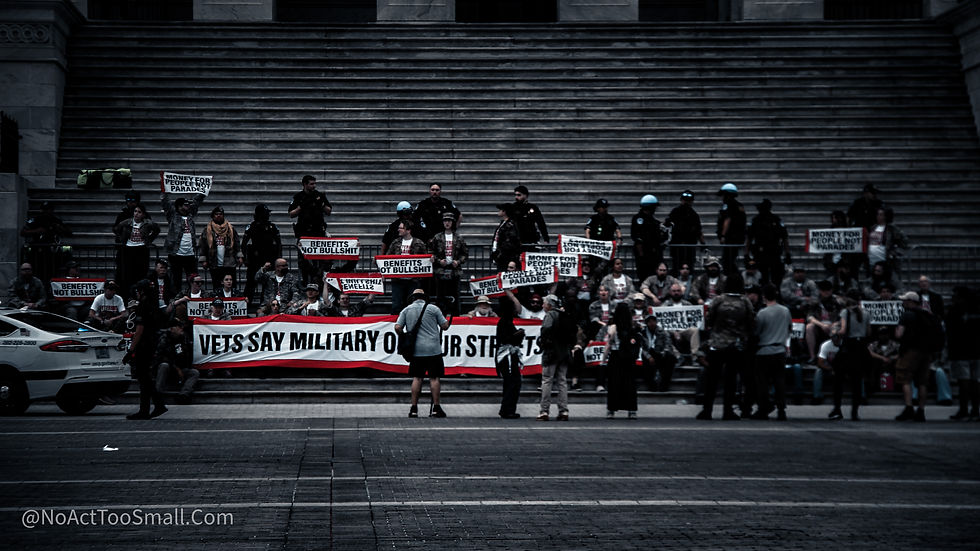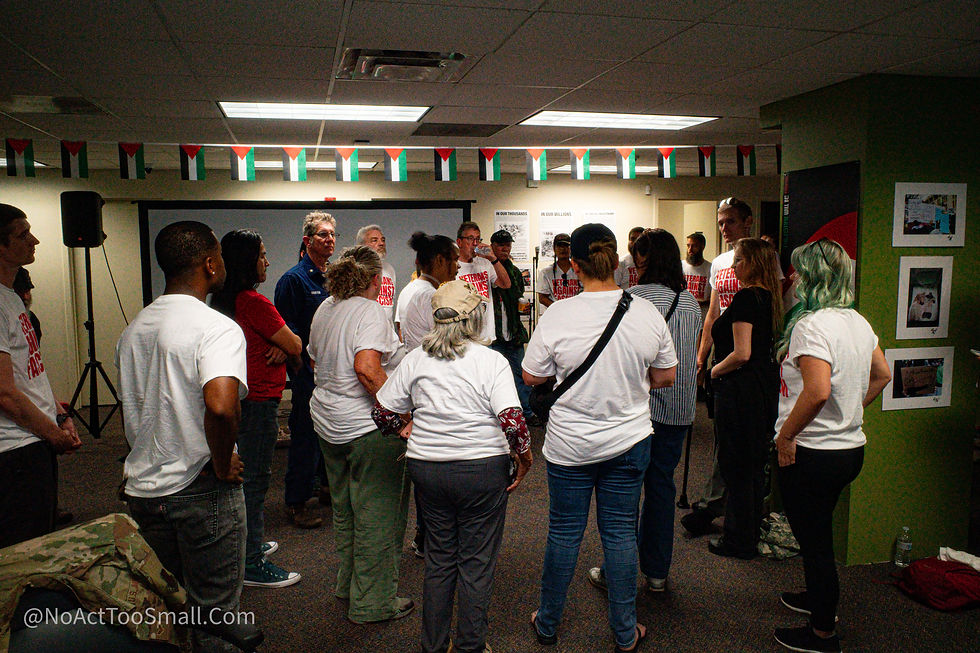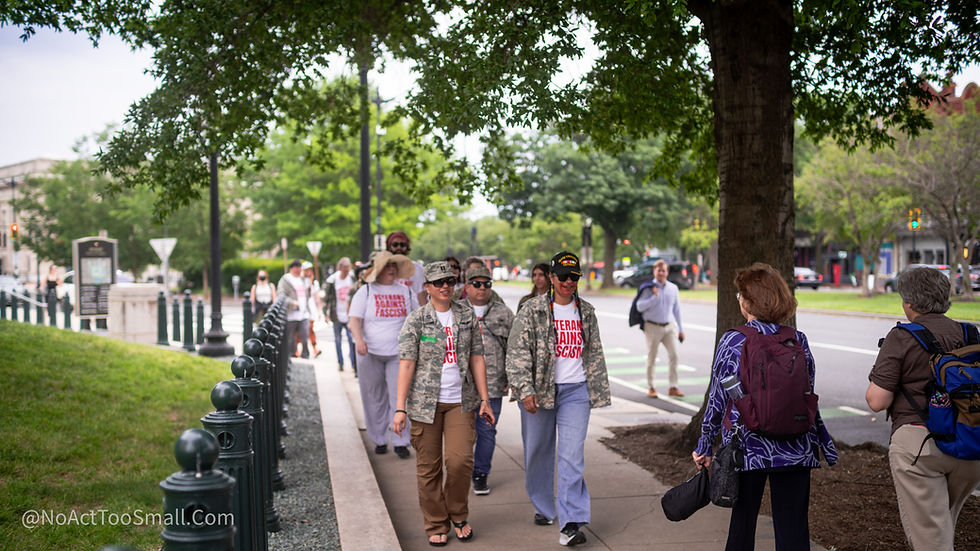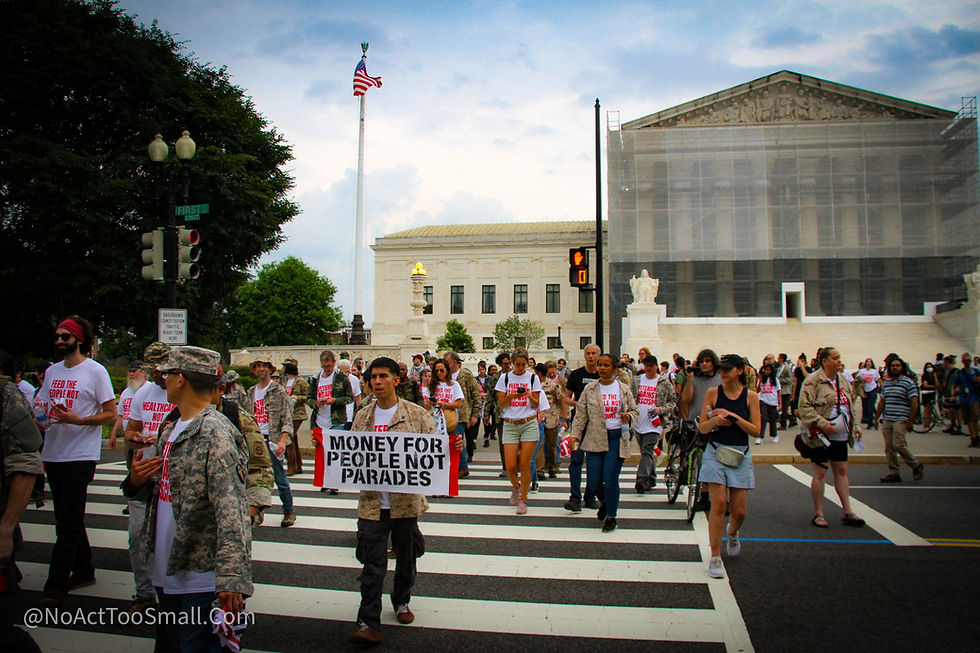The Line We Chose to Cross: A Veteran-Led Act of Conscience in D.C.
- Jun 16
- 8 min read
By Dave Otto

On July 13, 2025, a group of veterans and allies gathered in Washington, D.C. to stage a public act of civil disobedience against militarism, state violence, and the politicization of the armed forces. What followed was not just a protest—it was a moral reckoning. Some came to be speak out, others to bear witness, but all came with purpose. This photo essay captures that day from the inside: from the quiet moments in a community center basement to the chants echoing across police barricades. I was there to participate to observe—and stood in solidarity. The story that follows is not the official version. It is the one I observed.
Prelude: In the Company of Conscience

We’d been talking for weeks—over chats, and calls, planning plans. Now we were here, together, in the basement of a D.C. organizing space. The kind of place that smelled of carpet glue and purpose. A space big enough for a potluck, an art-build, or staging an action.
The walls were green in parts, beige in others. The chairs—gray, stackable, institutional—lined the walls or gathered in circles, rarely used, as most folks stood or leaned in conversation. There was a table with water bottles, handouts, and pizza. Enough fuel for what we came here to do.
The room was as diverse as the country itself—Black, brown, white, queer, trans, disabled, immigrant, native-born—all of us bound not by uniform, but by conviction. A kind of gritty, principled solidarity that felt like the best of what America could be.
There were Cold War vets among us. Vietnam vets, an old fellow in a red shirt with a Ho Chi Minh quote on the back. Gulf War veterans and seasoned peace activists who knew this rhythm well. For some in the group, it was a reunion—grizzled hands clasped over decades of shared struggle. For others an introduction—those from the post-9/11 wars—it was something newer, something rawer. The war stories the younger vets carry are still hot to the touch.
Some found quiet corners, backs against walls, legs outstretched. Others gathered in tight knots, joking, reconnecting, prepping. One vet in full Coast Guard blues sat cross-legged on the carpet, his green duffel bag nearby like a shadow from another life. Someone passed out sharpies and cards for contact info Our main organizer, a former Army Captain, sat behind a laptop covered in stickers: Fight Poverty Not the Poor, Vote With Love, About Face. She looked up, calm and unflinching, ready.
With the hurry up and wait part of the day over, we formed a loose circle. Not for a sermon, but for grounding. Support teams were introduced, the media and police liaisons. The roles were clear. The risk was real and well understood. After all, hadn't the President promised a crack down on any and all dissent? We were aware also of reports of militant Trump supporters looking to cause problems.
Then the ask: a collective affirmation of nonviolence. Not theoretical. Not “unless.” Nonviolence even if provoked. Even if threatened. If you couldn’t commit to that, you were in the wrong place.
No one came to battle the Capitol Police, smear shit on the walls, or hang the Vice President. That was never the point. This wasn’t about theatrics or confrontation for its own sake. It was about bearing witness—to a future worth fighting for.
I hold as a core principle of existential-humanistic thought that if you truly value something, you will choose it freely—aware of the alternatives and understanding the consequences. And that’s what this was: a gathering of people who had made a clear-eyed choice. Veterans who once followed orders now choosing to resist them, not out of bitterness, but in service to a deeper loyalty—one rooted in justice, care, and the refusal to be silent.
In that room, it was clear: this wasn’t nostalgia, and it wasn’t performance. It was the embodiment of a promise—to never again be used against the people, to turn the tools of war into instruments of peace. Most wore old uniforms, some wore T-shirts with slogans in bold red letters, but all wore the weight of what we know, what we have lived.
The room held quiet resolve, a gentleness, not rage. And as we prepared to walk toward the Supreme Court and ultimately the Capitol, toward whatever came next, it felt less like a protest and more like a rite. A line was being drawn—not in defiance alone, but in fidelity to something higher than orders or flags. In choosing to resist, we were once again serving our country. Not the spectacle, but the soul.
Part 2: Moving into Position

We didn’t call it a march. There were no formations, no bullhorns, no banners, no slogans echoing down Pennsylvania Avenue. It was a walk. A friendly, loosely gathered stroll under the thick humidity of a D.C. summer, the kind of heat that makes your skin remember where you’ve been stationed, what you’ve carried.
We walked past commuters, office workers, tourists, and an occasional police cruiser. We weren’t trying to provoke attention—we were trying not to. That was the point. We didn’t want to invite confrontation with militant counter-protesters looking for a reason. That would fit thier narrative, not ours. We had a message to deliver.
Some of us wore T-shirts with bold red text: “Veterans Against Fascism”, “Feed the People, Not the War Machine,” “Healthcare Not Warfare.” Others wore pieces of uniform—camo jackets, old boots, a Coast Guard jumpsuit, faded unit patches. Patches stitched to sleeves for us old-timers, velcro for the younger set. Each step was quiet, but not casual. We were walking in the service of a shared conscience.
We arrived in front of the Supreme Court not as a flash mob, but as a presence. The press had been alerted, and a few cameras were already waiting. That’s when the banners came out—“VETS SAY MILITARY OFF OUR STREETS” stretching wide across the steps, flanked by signs that read “MONEY FOR PEOPLE, NOT PARADES.” It wasn’t long before the chants started: “Benefits Not Bullshit.” It came out of someone’s gut like a dare, and the rest of us picked it up. It was loud, then louder.
People stopped. Tourists. Staffers. Dozens, then hundreds, formed an informal crowd around the press conference. And then came the testimonies.
Veterans stepped forward—some shaking, some unshakable—and told their stories. About moral injury. About being sent to fight abroad while their neighbors at home couldn’t afford healthcare. About watching tanks roll into American cities, not in training drills, but in protest crackdowns. They spoke about promises made, broken, and reclaimed. They spoke not as victims, but as witnesses.
This wasn’t just an action. It was an intervention. In the shadow of the nation’s highest court, we declared a deeper loyalty—not to blood and soil, but to humanity. Not to orders, but to truth. Not to spectacle, but to solidarity.
Part 3: The Walk to the Capitol Steps

The press conference dissolved the way good ones do—without ceremony. A final chant, a round of claps, a few hugs, and then a subtle shift in the current. The front of the Supreme Court emptied, but nobody scattered. We knew we weren’t done. Not even close.
There wasn’t an announcement. No orders barked, no whistles blown. But something moved through the group—an unspoken signal. We know the destination. People began walking—not milling, not wandering—walking deliberately toward the Capitol. You could feel it in the air, like the moment before a storm. Some folks in the crowd—bystanders, supporters, maybe even a few press—may not have known the next step. But they knew something was coming.
We turned west, toward the dome—toward power, toward history, toward the line was about to be crossed.
It’s a short walk, maybe a quarter mile. But we took it at a pace that was brisk, decisive. It wasn’t hurried, but it wasn’t casual either. This was a move, and everyone knew it. Some adjusted their backpacks. Others tightened scarves, rolled sleeves, and passed water bottles. A few took deep breaths, shoulders back. It wasn’t rehearsed, but it was prepared.
The Capitol came into view, glowing white behind haphazardly erected barricades and fencing. The same building where just a few years earlier, mobs stormed the halls in rage and delusion. But this wasn’t that. This was something else entirely. There was no bloodlust in our step. No chaos in our eyes. This was intentional. A calm and courageous decision to bear witness and share our truth.
We were headed toward the east plaza—not to destroy, but to reclaim. Not to provoke, but to insist. We were about to cross a different kind of line. One not marked by tape or fencing, but by conscience.
Part 4: The Steps
Things happened fast—faster than any plan could fully contain. One moment we were clustered at the barricade, the next, people were in motion. There will be official versions of what happened, filed by police, framed by press. But we had our own truth. We were there. We saw it unfold.
From where I stood, I wasn't in the middle of the chaos, but it felt it—like a pulse surging outward. The barricade wan't a barricade at all. There were fences in places, no fence in others. I asked a Capitol Police Officer if I could move forward, and I got a gruff "No!", as I watched ten other people with cameras casually walk past. Note to self for next time: it's better to ask for forgiveness than permission.
Veterans surged forward fast before the Capitol Police even realized the push had begun. I was reminded of a young Kevin Bacon playing a police officer in the 1978 hit film "Animal House".
The flow was too much to contain. Those who had committed to bear witness were moving, and the rest of us were there to support.
There were shouts—some of urgency, some of joy. I saw a few get tackled, hard. One elder with a walker made it partway before being detained. Saddest police chase ever. But most people simply moved quick and clean, up the stone expanse of the plaza and onto the East Capitol steps.
And then they sat. The banners unfurled like a promise kept:
VETS SAY MILITARY OFF OUR STREETS
BENEFITS NOT BULLSHIT
MONEY FOR PEOPLE, NOT PARADES
The crowd looking on matched them in voice. Call and response rang out across the plaza. Their chant on the steps, our echo at the fence.
It was a communion of purpose, divided by a barrier but united by conscience.
Police reinforcements poured in—helmets, zip ties, radio chatter. But no violence came from our side. That was the point. This was not about provocation. It was about presence. A moral interruption. Civil disobedience at its clearest.
As Vets were detained—some gently, others not—we watched, documented, and supported. We called out names, took photos, sent texts to jail support. Our job was to witness, to protect with presence and accountability, and to ensure no one disappeared without someone noticing.
The real breach didn’t start at the barricade.
Long before we crossed the line, our political leaders had crossed theirs—red lines of truth, justice, and human dignity. We occupied the Capitol steps, however briefly, not for spectacle, but as a moral warning:
That if they will not be bound by conscience, we will make our presence the alarm.
To be continued...



































































































Comments